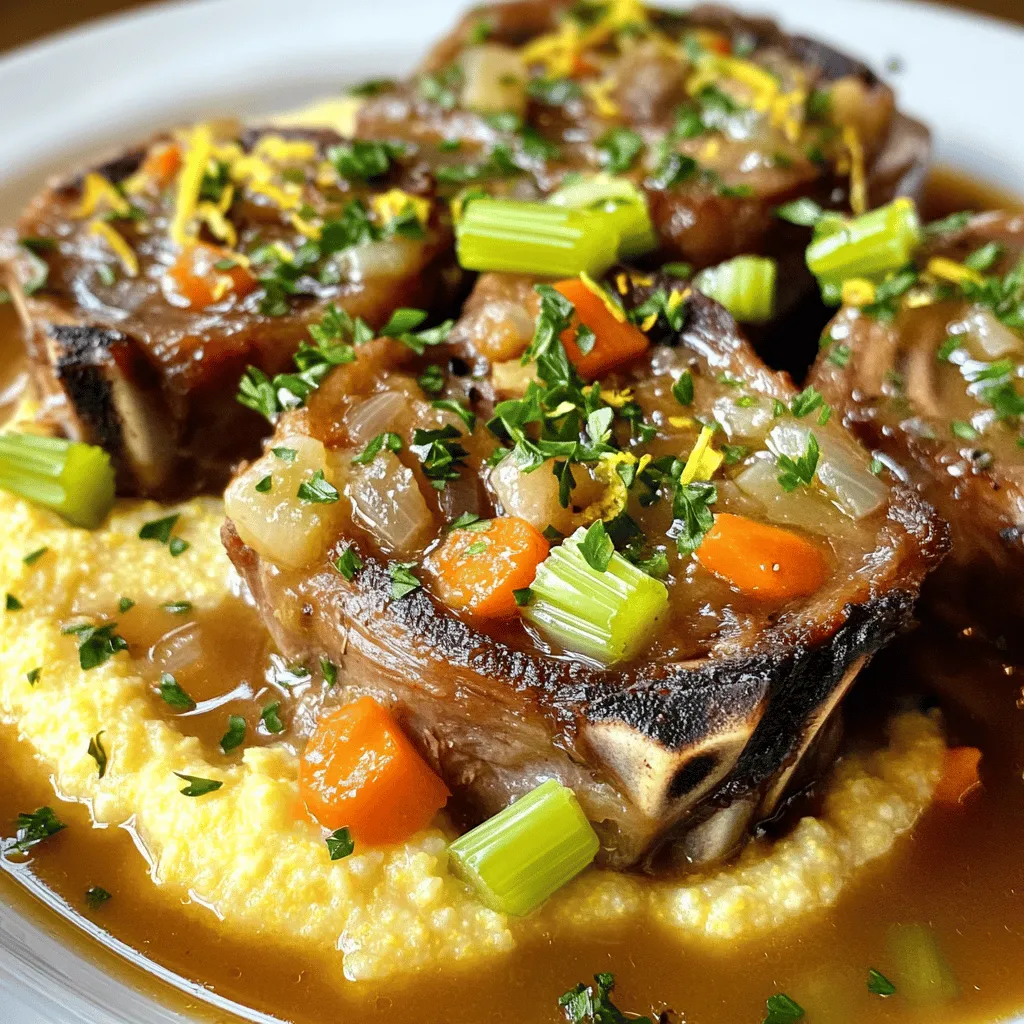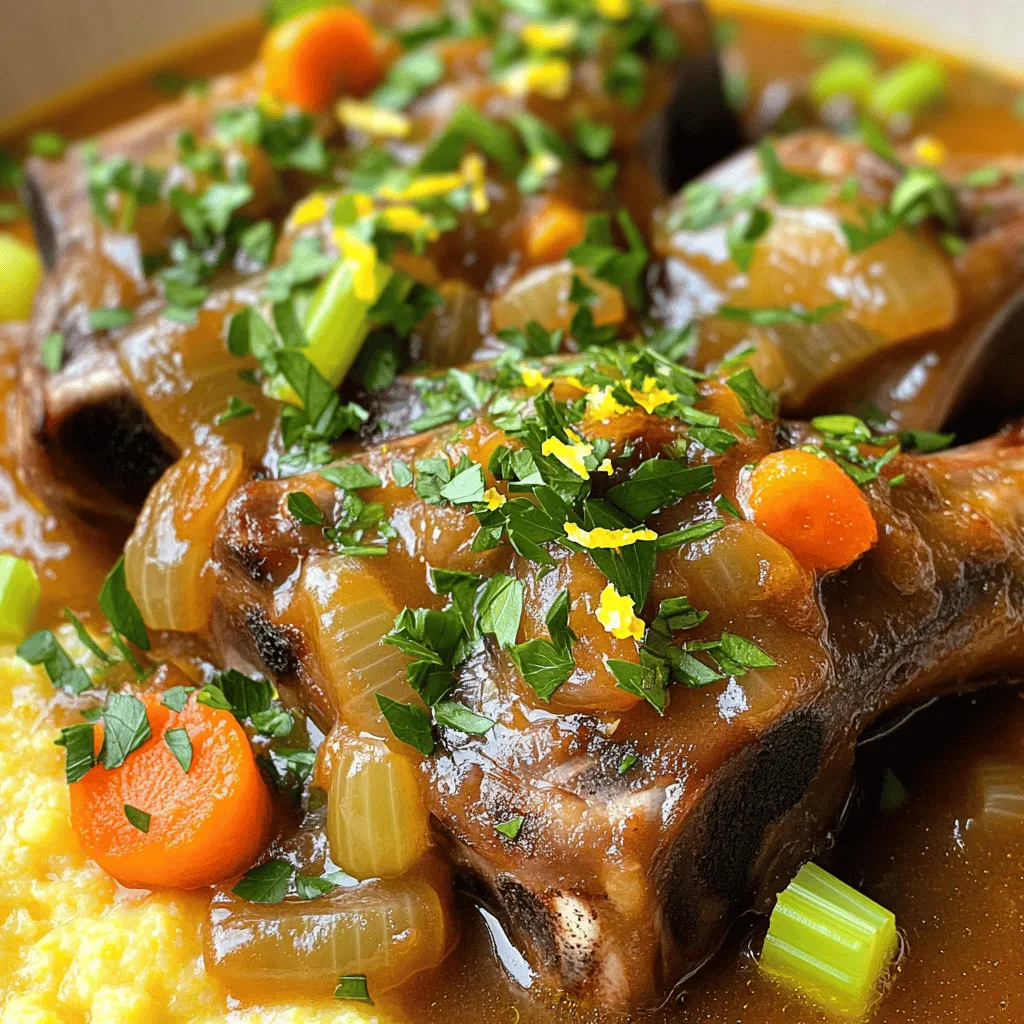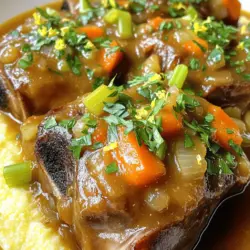Are you ready to impress your friends and family with a mouthwatering dish? Braised Pork Osso Bucco is a classic meal that brings rich flavors and warmth to your table. In this flavorful cooking guide, I’ll share essential tips on choosing the best pork cuts, mastering braising techniques, and pairing delicious sides. Whether you’re a novice cook or a kitchen pro, you’ll find everything you need to create this stunning dish!
What Ingredients Do You Need for Braised Pork Osso Bucco?
To make a great braised pork osso bucco, start with the right ingredients. The main star is pork shanks. These cuts are rich and meaty. Look for four pieces, about two inches thick. This gives you the best flavor.
Next, gather your veggies. You need one large onion, two carrots, and two celery stalks. Dice them well. These vegetables add depth to the dish. You also need three cloves of garlic. Minced garlic brings a lovely aroma.
For the sauce, you will need one can of diced tomatoes. This adds sweetness and acidity. A cup of chicken broth keeps the dish moist. Fresh lemon juice and zest brighten up the flavors. Use one lemon for this.
Now, let’s talk seasonings. You will need one teaspoon of dried thyme. It gives an earthy note. A bay leaf is also key for that classic taste. Salt and pepper are essential for balancing the flavors.
Don’t forget the garnish! Fresh parsley adds color and freshness. It is a simple touch that makes the dish pop.This dish is all about rich flavors and tender meat. Enjoy the process of making a comforting meal.
How Do You Prepare Braised Pork Osso Bucco?
To cook osso bucco, start by gathering all your ingredients. This dish needs pork shanks, olive oil, onion, carrots, celery, garlic, diced tomatoes, chicken broth, lemon, thyme, bay leaf, salt, and pepper.
What Are the Step-by-Step Instructions for Cooking?
1. Preheat your oven to 325°F (160°C).
2. Heat olive oil in a heavy pot over medium-high heat.
3. Season the pork shanks with salt and pepper.
4. Sear the pork shanks until they are browned on all sides. This takes about 3-4 minutes per side.
5. Remove the pork and set it aside.
6. In the same pot, add the diced onion, carrots, and celery. Cook for about 5 minutes.
7. Add minced garlic and cook for one more minute.
8. Pour in the diced tomatoes and chicken broth. Scrape the pot to loosen any flavorful bits.
9. Stir in the lemon zest, lemon juice, thyme, and bay leaf. Bring to a simmer.
10. Return the pork shanks to the pot, partially submerging them in the liquid.
11. Cover and transfer to the oven, braising for 2 to 2.5 hours.
12. Once cooked, remove the bay leaf and taste the sauce, adding salt and pepper as needed.
13. Serve the osso bucco hot, garnished with parsley.
How to Properly Sear the Meat?
Searing the meat is key to building flavor. Use a heavy pot to heat the olive oil. Make sure the oil is hot before adding the pork. This will help create a nice browning effect. Sear each side for 3-4 minutes until golden brown. If you crowd the pot, the meat will steam instead of sear. So, do it in batches if needed.
What Should You Avoid During the Cooking Process?
Avoid skipping the searing step. This adds depth to the flavor. Do not rush the braising time. If you do, the meat may not become tender. Also, steer clear of adding too much liquid at first. You want the pork to soak up the flavors as it cooks. Lastly, don’t forget to taste and adjust the seasoning at the end. This is where you can elevate your dish!

What Are the Best Braising Techniques for Pork?
Braising pork brings out rich, deep flavors. You can use two main methods: stovetop and oven. Both are great for osso bucco, but they have some differences.
How Does The Braising Process Affect Flavor?
Braising combines dry and wet heat. First, you sear the meat. This step locks in flavor and creates a nice crust. After searing, you add liquid and cover the pot. The steam helps tenderize the meat. This slow cooking makes the flavors meld beautifully. You get a dish that is savory and satisfying.
What Timing Should You Consider for Tender Meat?
For tender osso bucco, timing is key. I recommend braising for 2 to 2.5 hours at 325°F. This low and slow method breaks down tough fibers. You want the meat to fall off the bone. If you check too soon, it may be tough. Trust the process. Use a fork to test the meat’s tenderness.
How Can You Master Different Braising Methods?
To master braising, practice is essential. Learn to control the heat. If you cook on the stovetop, keep it at a low simmer. In the oven, ensure an even temperature. You can also experiment with different liquids. Chicken broth works well, but you could try wine or stock. Each option adds unique flavor.
What Variations Can You Try for Osso Bucco?
When it comes to pork osso bucco, many variations exist. Each region adds its twist. For instance, Italian osso bucco may use veal, but pork shines too. You can also find versions with different herbs, spices, and even sauces.
What Are Some Traditional Variations of the Recipe?
In Italy, osso bucco often includes gremolata. This mix of lemon zest, garlic, and parsley brightens the dish. In France, some chefs add white wine for extra depth. In Spain, they may use paprika and saffron, giving the dish a unique flair. Each variation highlights local flavors and ingredients.
How Can You Adapt the Recipe for Dietary Preferences?
You can easily adapt osso bucco for dietary needs. For a gluten-free option, use gluten-free broth and skip any flour. If you’re looking for a low-sodium version, use low-sodium broth and fresh herbs to boost flavor. For a vegetarian take, swap the pork for hearty mushrooms or eggplant. The key is to keep the rich flavors while meeting your needs.
What Unique Flavor Combinations Enhance Osso Bucco?
To enhance the flavor of osso bucco, consider adding different spices. A touch of smoked paprika can add warmth. Fresh herbs like rosemary or oregano can bring a fresh taste. You can also experiment with citrus. Adding orange zest or juice can give a nice twist. These combinations can elevate your pork osso bucco from good to great.

What Are the Best Side Dishes to Pair with Osso Bucco?
Osso bucco is rich and flavorful. It needs sides that balance its taste.
Which Sides Complement the Richness of Osso Bucco?
Creamy polenta is a great choice. It soaks up the sauce and adds a nice texture. Mashed potatoes work well too. They are soft and buttery, perfect for the savory sauce.
You can also try risotto. Its creaminess and lightness pair nicely with osso bucco. A side of roasted root vegetables adds color and sweetness. Carrots, parsnips, and sweet potatoes complement the dish well.
How to Choose Seasonal Vegetables to Serve?
Seasonal vegetables bring freshness to your plate. In spring, think about asparagus or peas. They add a bright, crisp taste. In summer, choose zucchini or tomatoes. They provide a light and juicy flavor.
In fall, butternut squash or Brussels sprouts shine. They offer warmth and sweetness. Winter calls for hearty greens like kale or Swiss chard. These greens add a nice bite to the meal.
What Side Salads Work Well with the Dish?
A simple arugula salad is a great option. It has a peppery taste that cuts through the richness. Toss in some lemon juice and olive oil for brightness.
A classic Caesar salad also complements osso bucco. Its creamy dressing and crunchy croutons add texture. A beet salad with goat cheese brings earthiness and creaminess.
These salads add freshness and balance to your meal. Serve them alongside your osso bucco for a full dining experience.
How Can You Serve and Garnish Braised Pork Osso Bucco?
Serving braised pork osso bucco is all about making it look great. You want your dish to shine on the table. Here are some tips for an impressive plate.
Start by placing the osso bucco in the center of the plate. Add a scoop of creamy polenta or fluffy mashed potatoes underneath. This base soaks up all the rich sauce. Drizzle some of the braising liquid around the meat for extra flavor. A sprinkle of fresh parsley adds a pop of color.
Next, let’s talk about garnishes. Gremolata is a classic choice. It’s a mix of lemon zest, garlic, and parsley. This adds a fresh and zesty kick to the rich meat. You can also try roasted vegetables for added texture. They pair well with the tenderness of the pork.
Now, when should you serve osso bucco? It shines on special occasions. Think family dinners, holidays, or gatherings with friends. Its hearty flavor makes it perfect for chilly nights. You can impress your guests with this dish, and they will love it.
Braised pork osso bucco is rich, flavorful, and perfect for any meal. We covered key ingredients, cooking methods, and techniques to make the meat tender. You learned about traditional variations and the best sides to serve. Remember, garnishing with gremolata adds fresh zest. Experimenting with flavors will make your dish unique. Osso bucco is not just a meal; it’s an experience worth sharing. Enjoy crafting this delicious dish and impressing your guests with your newfound skills.



